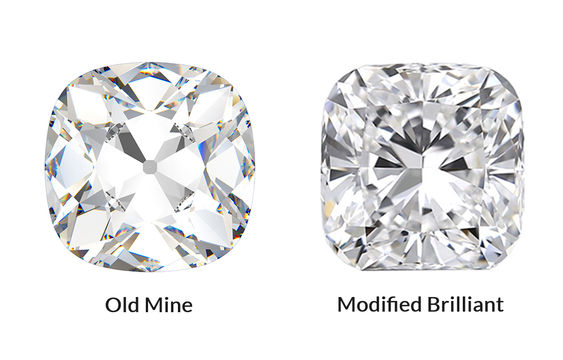Click here to get this article in PDF
Rounds and Cushions are old diamond cuts. However, the brilliant faceting patterns that are popular today were not the original way these diamond shapes were cut. Originally known as Old European Cuts and Old Mine Cuts, the evolution of these two antique cuts is quite similar.
Old Mine Cuts (Antique Cushions)
Old Mine cuts date back to the 1700s but were not made popular until the Victorian and Edwardian Eras, but did not become popular until a century later. Compared to modified brilliant cushions, antique cushion cuts also have 58 facets. These vintage cuts also feature an open, visible culet at the bottom, steeper crown, and are known for their “chunky” faceting.
Originally, antique cushion cuts were the only way to cut this shape of the diamond. They were cut by hand under candlelight, which earned them the nickname Candlelight Cut. As time went on and technology improved, diamond cutters began favoring different cushion cuts as antique cushions required the cutter to cut more of the rough diamond than any other shape.



4.39 carat Antique Cushion Diamond Engagement Ring
Old European Cut
Old European Cuts entered the diamond market in the late 1800s and became quite popular during the Art Deco period. Unlike antique cushions, they were not the first iteration of a round diamond, but they were an early predecessor to the Round Brilliant diamond.
Similar to Antique Cushions, Old European Cuts have 58 facets and were cut with candlelight in mind. They were not cut to maximize brilliance, but carat weight. They are characterized by their distinctive faceting pattern of large facets and the small circle in the center of the diamond’s table, also known as the culet.



3 carat Old Euro Lab Diamond Pave Engagement Ring
Ratio Comparison
All cushion cuts tend to fall within the length to width ratios of 1:1 for a squarer look, all the way to about 1:1.2 for a more rectangular/elongated look. We find the 1:1.1 ratio a popular range for elongated cushions. Generally, an elongated cushion will look bigger on the hand because it takes up more length on the finger.
For all rounds, however, there isn’t a range of ideal ratios as they should be perfectly symmetrical. In this case, the ideal ratio for all round cut diamonds should be 1:1 or 1:1.05 at the very most!
Cut Comparison
People often confuse Old European and Old Mine as they have similar names and are both antique cuts. Additionally, rounds and cushions are similar in nature, but there are a few key distinctions between these two cuts.
Old European Cuts and antique cushion cuts are both known for their chunky facets and open culet, however Old European Cuts are round and antique cushions are square with rounded edges.
Both rounds and cushion cuts hide color and imperfections rather well so we recommend opting for Old Euros or Antique Cushions with a color grade of J or above and/or clarity of SI2 or above. However, if you are looking to make the stone appear more vintage, you can go lower in color grade.
Would You Choose an Antique Cut?
Both of these cuts offer a glimpse into history while still radiating beauty. At Lauren B, we have an exclusive inventory of loose stones, including many Old European Cuts and Antique Cushions.
Schedule an appointment with one of our design consultants to design your perfect vintage-inspired ring. You can also check out our Instagram or Pinterest for inspiration!
